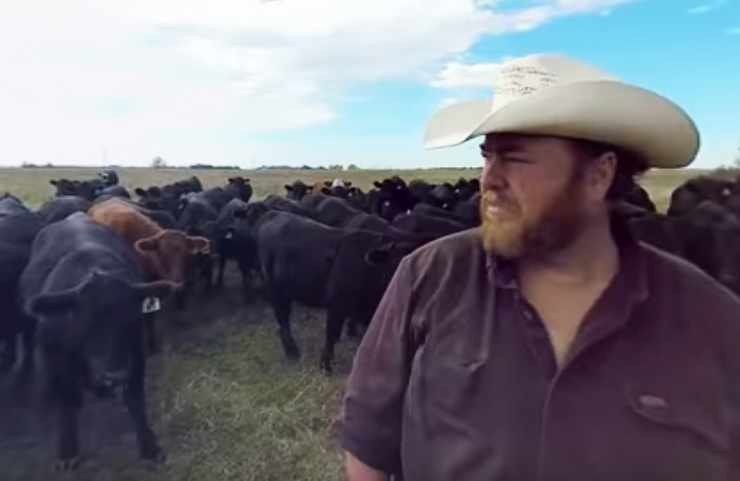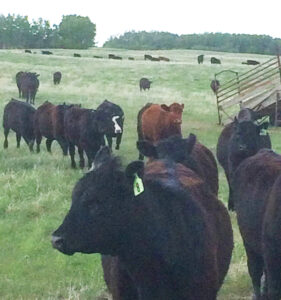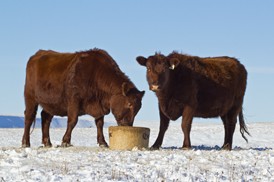Copper Deficiency Takes Heavy Toll
Water testing can help prevent a wreck in reproductive performance

Garret Hill couldn’t figure out what was wrong. Cattle had plenty of grass, clean water, a standard mineral mix in front of them, they appeared to be in good condition, yet conception rates among cows and heifers on his family’s central Saskatchewan ranch were declining.
This problem came to a head about six years ago. Their area around Duval, about an hour north of Regina, had experienced a succession of particularly wet growing seasons. There was plenty of grass and a relatively deep (150 foot) well on the farm supplied water to the herd as needed during the year.
“We didn’t know what was wrong,” says Hill, who along with brother Greg and other family members today run about a 1,000 head cow-calf operation. “But at that time we had about one-third of the cow herd open and it seemed to be increasing by about five per cent per year. The problem was getting worse.”
It was during preg checking session that the alarm went off. Brother Greg Hill had called local veterinarians Laurie Zemlak and Tanya Marshall from the TM’z Veterinary Clinic at Lumsden to handle the annual preg check at the ranch. During that session Zemlak and Marshall noted a higher than normal percentage of opens. They in turn called in specialists from the University of Saskatchewan, Western College of Veterinary Medicine (WCVM) to investigate. The WCVM researchers had several blood samples from the cowherd analyzed.

“It came down to a copper deficiency,” says Hill. “The blood tests showed a serious copper deficiency. They figured it was like a perfect storm. Our well water was high in sulphates, and with wet conditions our grass was high in molybdenum — both high sulphates and molybdenum will tie up copper. And copper is essential to reproductive performance. We were feeding copper in our mineral mix, but it wasn’t in the right form.”
The combination of high sulphates in the water, as well as high molybdenum levels in forages was a double whammy on copper. The cattle couldn’t get enough copper into them to overcome the adverse affect of sulphates and molybdenum. And Hill says with a herd calving in late May and June and later to be bred in August and September, the deficiency was probably peaking just at breeding season.
Working with nutritionist Blake MacMillan from Blair Livestock Nutrition, they got the herd switched to a chelated mineral formulation. That was an important first step in correcting the problem. Chelated minerals are an organic source of minerals and generally are more readily available, more easily absorbed by cattle. They are more expensive than a standard mineral but can be more effective, especially when correcting a deficiency.
“We saw phenomenal results, once we switched minerals,” says Hill. “All we use now are the chelated minerals. You think they cost more, but they really don’t. If you start having open cows because of a mineral deficiency, that is way more expensive than the minerals. If we hadn’t got the help to figure out what was wrong in our herd, I know we would have been out of business.”
“My advice to other beef producers, if you’re seeing some performance problem in your herd — get your water tested, have some blood tests done and feed chelated minerals,” says Hill.
The particular situation Garret Hill experienced with nutritional imbalances that led to poor conception rates in their beef herd isn’t an epidemic by any means, but it happens more often than producers realize. Hill says since his problem with open cows he’s talked to other producers with similar situations. “There appears to be pockets of this here and there,” he says.

Dr. John McKinnon, Saskatchewan Beef Industry Chair and professor in animal science at the University of Saskatchewan, says it can be an issue in all parts of the country and it is a combination of factors, which contribute to performance issues. Peter Vitti, a Western Canadian beef and dairy nutritionist says often an important link in correcting livestock performance issues involves supplying cattle with a properly formulated mineral mix.
Dr. Cheryl Waldner, a professor and researcher at the Western College of Veterinarian Medicine says even what appears to be “good water” can be the source of a performance problem in cattle.
“Problems can arise, particularly when producers are sourcing water from deep-drilled wells,” says Waldner. “Wells that are up to 100 meters deep or more often tap into old aquifers that can be high in total dissolved solids and sometimes sulphates and iron.”
“In addition to water quality challenges, most soils in Western Canada are naturally copper deficient,” she says. “So it is important that livestock receive a mineral supplement that contains copper. We know that copper is one of the trace minerals essential to proper reproductive performance in cattle. The lower the copper level, the lower the conception rates, especially in young cows.”
If cattle are supplied a water or feed high in sulphur, or iron, or if they encounter a feed source that’s high in molybdenum, for example, those elements tie up copper and therefore can reduce reproductive performance. Very high sulphate well water can also contribute to cases of polio in cattle as well.
John McKinnon says the overall dietary concentration of sulphur can get pushed higher depending on the type of feed, too. Distillers’ grain and canola meal, for example, can be high in sulphur. “In a feedlot situation, a water source might have a sulphur concentration of 1000 ppm,” says McKinnon. “But if there is distillers’ grain or canola meal in the ration those feeds could increase the overall dietary concentration of sulphur to values higher than the recommended maximum intake of 0.3 to 0.5% of dry matter for example. If you are feeding breeding age females, those higher sulphur levels can affect mineral status (i.e. copper) and ultimately conception rates, and in a feedyard those higher levels, along with added stress, can also increase the risk of polio in feeders.”

“The copper requirement isn’t huge, but it is important,” says McKinnon. “In an average situation daily intake of 10 ppm of copper is sufficient, but if a person is seeing performance issues or dealing with high-sulphur water, it may need to be bumped to 20 to 25 ppm.”
Waldner says she would encourage producers to be proactive. Particularly if they are using water from a deep well. Have the water quality tested and supply a good quality properly balanced mineral mix that contains copper. A lower-cost inorganic mineral mix may be sufficient, but if that is not effective chelated formulations might be an option.
“While a properly formulated mineral supplement should be able to account for high sulphate or iron in water, or a feed source high in molybdenum,” says Waldner, “there is still a challenge to get the right amount of mineral into the animals.”
And that can be a multi-fold problem… Mineral intake is manageable in dairy barns where the mineral can be mixed directly into the ration. But in a beef operation with free-choice mineral, it can go a couple ways. Some producers not appreciating the value of mineral mixes, particularly during different stages of the cow’s reproductive cycle may figure it’s too expensive or too much trouble so the “mineral program” becomes a block of salt.
In other cases producers may put out a mineral supplement, but are unsure if it gets eaten. Cattle can be picky.
“It is important to do your best to monitor intake and determine if the herd is consuming suggested amounts,” says Waldner. “If you are using a blend that cattle seem to be ignoring, you may need to look at changing products or adding salt to make the mineral more palatable. However, some cows will still not consume enough while others might eat too much.”

Waldner says a year-round mineral program is preferred, but it is important producers make sure cattle at least have access to a properly balanced, palatable mineral mix particularly in the months leading up to calving and the subsequent breeding season.
Waldner says first and second calf heifers are most likely to exhibit signs (lower conception rate) due to copper deficiency, ahead of the mature cowherd, which appears to be more resilient with age. However, if there is doubt or suspicion about copper deficiency and other reasons for poor conception such as low body condition have been ruled out, she recommends blood samples be collected from the herd and tested. (Blood samples from about 10% of females should tell the story.)
Vitti says in his practice as a livestock nutritionist he has found there can be several factors that can affect reproductive performance — overall animal health, body condition score, environmental conditions, and feed quality — for example.
“Problems with reproduction can be caused by many different things,” says Vitti. “It is multifaceted. I encourage my clients to go with a good quality chelated mineral mix. If cattle are dealing with a copper or some other mineral deficiency, going with a chelated mineral just plugs that hole. If there was a deficiency, it is looked after and then you can look at what else might be a factor.” Vitti says if producers are concerned about a copper deficiency, having blood samples tested can be a useful tool, and if possible, a liver biopsy is the most definitive.
Vitti says a combination of minerals can be used during the year. During the summer and into early winter, he says a standard complete mineral mix, which costs about $25 to $30 per bag is sufficient. But in the later part of winter feeding, leading up to calving he recommends switching to a chelated mineral mix which might be about $45 per bag. “You may have two or three months where your mineral costs per cow are higher, but it is worth the investment,” he says. “Minerals are essential. A salt block is not enough.”
Click here to subscribe to the BCRC Blog and receive email notifications when new content is posted.
The sharing or reprinting of BCRC Blog articles is welcome and encouraged. Please provide acknowledgement to the Beef Cattle Research Council, list the website address, www.BeefResearch.ca, and let us know you chose to share the article by emailing us at [email protected].
We welcome your questions, comments and suggestions. Contact us directly or generate public discussion by posting your thoughts below.